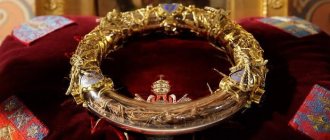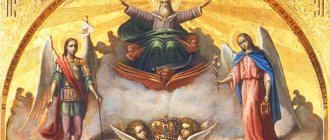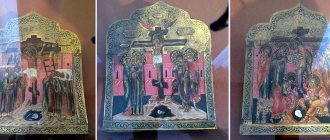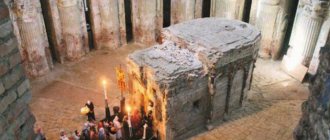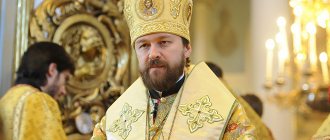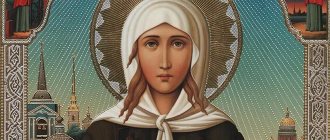Shroud of Christ
Christians carefully preserve shrines associated with the Savior. This is a tunic, the Cross of the Lord, nails, sir (a cloth from the head of Jesus). These also include the Shroud of Turin. Perhaps it was in this long cloth that the body of Jesus Christ who died on the Cross was wrapped. After the Resurrection of the Lord, the shroud remained in the tomb. On this canvas there are supposed traces of Christ's suffering on the Cross. However, some still doubt the authenticity of the shroud, preserved to this day, stored in the city of Turin (Italy).
Replica of the Shroud of Turin
Book
The book “Leonardo da Vinci and the Brotherhood of Zion” has been published. Revelations of the Templars." Its authors Clive Prince and Lynn Picknett came to the conclusion that the brilliant Leonardo da Vinci was directly related to the mysterious Shroud of Turin. The book reveals many secrets that may be hidden behind the sacred canvas.
I also recommend downloading the books:
- Shroud of Turin: the question remains open
- Word about the Resurrection. Shroud of Turin – Gospel History of Our Days
Shroud of Turin: description
The Shroud of Turin is a linen cloth slightly more than 4 meters long and 1 meter wide. On the golden-yellow fabric there are two dim prints of a naked male body in full length, front and back, located in a symmetrical manner - head to head. The images are quite clear, allowing you to see facial features in detail. The print on the fabric conveys the correct anatomy of the human body. Numerous bloody marks on the head (bruises from the thorns of the Crown of Thorns), on the chest and back (from blows with whips). Wounds are also visible on the wrists and feet (marks from the crucifixion). There is a large bloody spot on the left side (where he was wounded by the tip of a spear).
The deceased had long hair, a small beard forked in the middle, and a mustache. Facial features indicate belonging to the oriental (eastern) race (according to the classification of the French scientist Jean-Baptiste Borys de Saint-Vincent). According to the American anthropologist Carlton Stevens Kuhn (1904-1981), the appearance on the canvas belongs to a person of the Semitic type.
The Shroud captured numerous injuries on the face of the Deceased: swollen, broken eyebrows, a torn right eyelid, bruises under the eyes, a broken nose. The image on the shroud indicates that the wounded body was laid on one half of the cloth. The other part of the canvas was on top, covering the head and falling down from the legs.
From the imprint on the shroud one can get an idea of the appearance of the Deceased. This is an adult, physically developed person. Height was approximately 175-180 centimeters. He died shortly before being wrapped in the shroud. Moreover, according to scientists, the body was in contact with the tissue for no more than 40 hours - there are no signs of decomposition.
The Shroud of Turin also has darkened areas from prolonged storage of the cloth folded. Some of the dark streaks were the result of repeated fires and attempts to extinguish the fire with water. There are patches on the burned areas.
In pursuit of sensation
Years go by, but interest in the Shroud of Turin does not fade. And although access to the relic is limited, after 1988 scientists were able to conduct several more experiments.
Last year, the scientific world was shocked by the results of new research. University of Padua professor Julio Fanti decided to refute the conclusions of studies from the late 1980s. The original samples of the Shroud of Turin were subjected to infrared spectroscopy, as well as mechanical analyses. The research results completely contradicted the results of radiocarbon dating: according to Giulio Fanti, the Shroud of Turin may be three centuries older than Christ himself!
Criticizing the results of previous experiments, the professor did not say anything new. The fire and the use of oils allegedly played a cruel joke on scientists, causing them to make a thousand year mistake in dating. This version is set out in detail in Fanti’s book “Secrets of the Shroud,” co-written with journalist Saverio Gaeta. As in the case of Kersten, the classic pattern of “incredible discovery” can be traced here. All this is very reminiscent of a cheap sensation.
One of the latest studies was the work of Italian physicists Giuseppe Lacidogna, Alberto Carpinteri and Oscar Borla from the Politecnico di Turin, the results of which were published in 2013. Like Giulio Fanti, scientists criticized the findings of the 1988 experiment, only now the focus was not on fire or flood, but on earthquake. Allegedly, shortly before the execution of Christ, an earthquake occurred in Judea, which changed the properties and orientation of the particles on the canvas.
Naturally, this version also does not have any scientific evidence, and it is unlikely that it will appear. There are many seismically active places, but such phenomena have not been observed there.
The Shroud of Turin is a single piece of cloth, but the ancient Jews, as far as can be judged, used several pieces of fabric rather than whole shrouds in ritual rites. One of these panels, for example, was used to cover the head of the deceased. It turns out that the version of the authenticity of the shroud contradicts ancient Jewish customs.
©Flickr/John Mosbaugh
History of the Shroud
The linen used in the burial of Jesus Christ, who suffered on the Cross, is mentioned in the Holy Scriptures. After the Resurrection of the Savior, this shrine was kept by Christ’s closest disciples. Over time, the shroud was transferred from Jerusalem to the capital of Orthodox Byzantium - Constantinople (Istanbul, Turkey). In the Middle Ages, as pilgrims testified, the shroud of Jesus Christ was in the Blachernae temple.
In 1204, the Crusaders sacked Constantinople. Many Christian shrines, including the Shroud, were lost during the looting of the city. It was not until 1353 that the French Knight Templar Geoffroy de Charny, a descendant of a participant in the Fourth Crusade, announced his possession of the shroud.
Initially, the relic was kept in the possessions of de Charny in the city of Lirey (France). In 1452, the shroud came into the possession of Duke Louis I of Savoy in the city of Chambery (southern France). The capital of the Duchy of Savoy in 1578 was the city of Turin (Italy). The shroud was transferred to the Turin Church of John the Baptist, where it is now. That is why the Shroud is called the Shroud of Turin.
Where is the shroud and how to see it
The Shroud is called Turin only because for more than 4 centuries it has been in Turin in the Cathedral of St. John the Baptist (Cattedrale di San Giovanni Battista). The relic is hidden from the harmful rays of the sun and air in a special capsule, and its exact copy is put on public display.
The original shroud of Jesus is taken out for veneration very rarely, once every 25-30 years. The last time it was exhibited to believers was in the spring of 2010. This was done primarily in order to preserve the shroud and protect it from the effects of the external environment.
The cathedral is located in Piazza San Giovanni and is open to the public daily from 7 am to 7 pm, break 12:30-15:00. On Sunday the cathedral doors open at 8 am.
Cathedral of Saint John the Baptist in Turin
Not far from the cathedral is the Shroud Museum, where you can learn about the latest scientific research, see photographs of the sacred relic and study its history, starting from the moment it came to Turin.
The museum is located at Via San Domenico, 28, and is open to the public daily from 9 am to 7 pm with a break from 12:00 to 15:00. It is better to find out the cost of tickets, as well as changes in the museum’s opening hours, on the official website.
However, for those who plan to visit Turin and visit not only the Shroud Museum, we recommend purchasing a Turin tourist card, which gives the right to free admission to almost all cultural sites not only in Turin, but throughout the entire Piedmont region.
The card allows you to visit museums, exhibitions and palaces in the region for free, use tourist transport, and also save significantly on the purchase of excursions. It is valid for 2, 3 or 5 days to choose from. Details and prices for the Turin + Piedmont pass can be found here
Photos by: Yuval Y, Geobia, Paul Munhoven, stephane333, Jean-Pierre Dalbéra
Is the Shroud of Turin connected with Christ?
In 1898, with the permission of the Catholic Church, an amateur photographer from Italy, Secondo Pio, took the first photograph of the Shroud of Turin. When developing the film, the photographer discovered that using the negative could show the image more clearly. The face from the Shroud of Turin fully corresponded to the canonical Image of the Savior. The photograph provided an opportunity to examine the wounds, which became a world sensation.
“The Holy Shroud of Christ itself, in some unimaginable way, is a photographically accurate negative; and even with great spiritual content! This Holy Shroud, this amazing human-sized negative, is much more than a thousand years old. But our newly invented photography is only 69 years old!.. Here, in these brown prints from the Holy Sepulcher, lies an inexplicable miracle” (from the memoirs of Secondo Pio, 1907).
Since that time, the Shroud of Turin has been repeatedly subjected to all kinds of scientific research.
"The Fifth Gospel"
“If confirmed to be authentic, it will become the Fifth Gospel – another historical account of the passion and resurrection of Jesus Christ. The Gospels mention that Jesus Christ was scourged before His crucifixion, but only the Shroud “tells” us how cruel it was. There were two soldiers who scourged Jesus Christ, and their scourges had metal spikes. Apparently there were at least forty blows, and they covered the entire back, chest and legs.
The Gospels say that the executioners placed a crown of thorns on the head of Jesus Christ in mockery. From the Shroud we learn that this was not only a method of humiliation, but also a continuation of torture. The thorns of the crown of thorns were so sharp that they pierced the vessels on the head and blood flowed abundantly through the hair and face of Jesus Christ. Exploring the Shroud, you can see the Passion of Christ - the beating in prison, His bearing of the cross, His fall under the burden from exhaustion" (Orthodox physicist, director of the Russian Center for the Study of the Shroud of Turin, Alexander Vasilyevich Belyakov).
For Christians, one thing remains indisputable: history does not know anyone who was beaten, crucified on the Cross, was wrapped in a shroud, but did not remain in it for more than two days. No one except Jesus Christ, who voluntarily accepted death on the Cross for the redemption of all mankind and resurrected on the third day after His death.
Abrasion on left knee
It is very likely that these facts were not known at all in the 13th century. And other details also correspond to this. On the side of the man’s body on the canvas is a wound very similar to the one inflicted by a Roman spear two thousand years ago. The abrasion on his left knee corresponds exactly to what would undoubtedly occur to a right-handed person carrying a cross that would knock him over several times. Another interesting fact is that the print on the canvas took 30 hours to develop - this corresponds to the fact that on the third day Jesus rose from the dead, as the Bible teaches us. One eye shows the imprint of a coin from the time of Jesus, and the canvas contains pollen from plants that are found in Palestine but not in Europe.
History of scientific research of the Shroud
Representatives of various sciences - physicists, biochemists, criminologists, medical scientific experts - began studying the Shroud of Turin several times.
In 1978, a comprehensive scientific study was carried out on the Shroud of Turin. The shrine was exposed to electromagnetic radiation in various spectra. Microphotography and chemical analysis of the smallest threads of fabric were carried out.
The results of the research showed that the Shroud of Turin has a miraculous image - the fabric does not contain any traces of dyes. The image itself on the canvas could only appear when the flax fibers burned out. The reason for this could be some powerful radiation from within (much like paper fades when exposed to sunlight). However, in practice this cannot be repeated even with modern scientific advances.
Also, the image on the canvas cannot be considered a print from the oil used during burial. In such a case, deformation of the image would be inevitable, but the Shroud of Turin has a clear image. Scientists explain the appearance of the image as a consequence of the flax fibers perceiving a strong flow of actively charged particles. This is reminiscent of the consequences of a nuclear explosion, provided that the tissue is preserved.
Scientists were also able to prove that the image on the canvas appeared after the bloodstains appeared. The blood on the tissue is human, group IV.
The Shroud of Turin is a scroll depicting the terrible execution of Christ. Thus, scientists in the field of forensic medicine have identified a complete correspondence of the traces on the Body of the Deceased with the sufferings of Christ described in the Holy Scriptures.
The special method of weaving the cloth also speaks in favor of the authenticity of the Shroud of Turin. Another piece of evidence is pollen found on the surface of the fabric from plants growing in the Middle East.
“The most important fact is that the shroud testifies not only to the crucifixion of the Savior, but also to His resurrection. This great miracle sets the limit to the possibilities of science. She cannot penetrate the mystery, but she can indirectly confirm the Gospel” (hieromonk Job Gumerov).
Reasoned hypotheses
In fact, at the end of the 14th century, the French bishop of Troyes, Pierre d'Arcis, called the Turin painting a fake. After many centuries of disputes between scientists and the church, modern science intervened. And in the twentieth century, the results of scientific examination were published, independently developed by three radiocarbon dating institutes - in Zurich, Oxford and Arizona. On October 13, 1988, modern science officially confirmed the authenticity of the Shroud of Turin, since the canvas, on which the imprint of a male figure is visible, dates back to the period between 1260 and 1390.
On the one hand, such a statement was supposed to resolve all disputes. But, on the other hand, this made the riddle even more mysterious. Such a paradox. We are talking about how the body print got onto the incriminated canvas. The most common hypothesis is that the body was placed in the lower half of the canvas with the head facing the center and the upper half of the canvas placed on top of the body. Then, probably with the same effect as newspapers turning yellow in the sun, the print fell onto the canvas. It shows signs of torture that exactly match the prison implements of Christ's time.
There are also nail marks on the feet and wrists. And it is this detail that is especially interesting. Because all medieval paintings depicting the scene of Christ on the cross indicate that nails were driven into the palms. According to historians, and according to reconstructions of the crucifixion, a nail had to be driven into the wrist in order for the tortured person to actually remain hanging on the cross. In addition, the nail driven into the wrist pushes the thumb into the palm in a special way, a detail that is accurately depicted on the Turin canvas.
Modern Science and the Shroud of Turin
In 1988, the Shroud of Turin was radiocarbon dated. The results obtained showed that the date of creation of the shrine (the age of the fabric) dates back to the 13-14th century. Suggestions about the deliberate creation of the shroud began to appear already in the Middle Ages. However, the American scientist Raymond Rogers, who took part in the research, suggested that the samples under study were taken from patches that appeared after the fire of 1532.
Russian biochemist Dmitry Kuznetsov put forward a different assumption. In his opinion, during a fire in the 16th century, under the influence of high temperature, radiocarbon changes in the structure of the canvas could have occurred. He conducted an experiment with ancient fabric from Israel, the age of which was determined to be 1800 years old. After intense heating, the result of radiocarbon dating indicated the origin of the fabric in the 15th century. Kuznetsov came to the conclusion that the Turin Shroud could also undergo biodegradation of chemical bonds under the influence of temperature. However, some scientists dispute this conclusion.
In the 21st century, with the advent of new technologies, the Shroud of Turin continues to be subjected to more and more research. Disputes about its authenticity continue to this day.
Healing and Insight
The second mystery of the Shroud of Turin is a special power that can heal people and give them vital energy.
Researchers have recorded waves of positive energy flows emanating from the canvas. Their presence was confirmed by psychics who annually visit the place where the relic is stored. The waves are uneven, their movement is chaotic, which makes it seem as if the fabric is breathing. Researchers of paranormal phenomena do not deny that the Shroud may well be “alive”, since it carries part of the energy of the higher mind.
The canvas has no equal among other relics in terms of its impact on humans. Perhaps if scientists were given the opportunity to study it in more detail, incredible discoveries would be made. But the church stops all attempts to reach her. Maybe church representatives are afraid of exposure, or maybe that they will try to destroy the Shroud.
Nowadays, fanatics do not give up trying to rid the world of the artifact; they believe that after it is gone, the world will plunge into chaos and darkness.
Official position of the Russian Orthodox Church
The authenticity of the Shroud of Turin is recognized by many Orthodox pastors, laypeople, and religious researchers. However, the Orthodox Church does not elevate such an opinion to the level of dogma. This is not a universally binding truth of faith. Everyone decides for himself whether to believe or not to believe in the authenticity of the Shroud of Turin.
“The Russian Orthodox Church has no official opinion regarding the Shroud of Turin. There are people who recognize its authenticity, and there are those who do not. I personally recognize the authenticity of this shrine” (Patriarch of Moscow and All Rus' Kirill).
As Metropolitan Hilarion of Volokolamsk noted, “standing before this shrine, we remember first of all the suffering and death of our Lord Jesus Christ.”
As an image of Christ's Passion on the Cross, the shroud has always been revered in Orthodoxy. Each temple has a symbolic image of the burial shroud. On Good Friday, when the death on the Cross and burial of the Savior is remembered, the shrine is taken out from the altar for veneration by believers.
If the Shroud of Turin is not authentic, what difference does it make?
The question of the authenticity of the Shroud of Turin does not in any way affect the foundations of the Christian faith. Admiration for her goes back to the Prototype, Christ Himself, who offered Himself as a Sacrifice for all people. Therefore, whether the Shroud of Turin is the original burial shroud of the Savior or not, this does not change anything for believers.
“Our faith is not in the Shroud, not in rational knowledge, but in the heart, in reverence and spiritual experience. “Blessed are those who have not seen and yet have believed.” The Shroud is needed for Thomas the Unbeliever” (Archpriest Gleb Kaleda, 1921-1994).
Read us conveniently on social networks:
Tags: face from the Shroud of Turin, shroud of Jesus Christ, shroud of Christ, this shroud, Shroud of Turin
